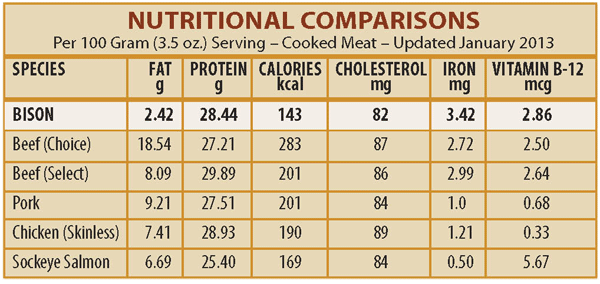

Why Bison?
Environmentalists like grass-fed bison because this method of meat production is more sustainable and less polluting than conventional methods. As bison graze, they keep the ecosystem in check by preventing grasses from overgrowing, while their waste nourishes the soil, among other benefits. Properly grazed grasslands can, in fact, help stem global climate change because they trap the carbon from greenhouse gases in the atmosphere and redistribute it in soil.
Whether 100 percent grass-fed or grain-finished, bison meat is leaner than beef, though grain-finishing does increase the fat content somewhat. And like all meat, it is rich in protein, iron, zinc, vitamin B12 and other nutrients. The National Bison Association promotes it as having only 2.4 grams of fat and 143 calories in 3.5 ounces cooked, compared to 8 grams of fat and 200 calories in a piece of “select” beef. That’s based on the leanest cuts, trimmed of all fat. Other bison cuts have 4 to 9 grams of fat and 165 to 190 calories, comparable to some lean beef cuts; ground bison meat can have 15 grams of fat and 240 calories in 3.5 ounces.
Bison meat is also promoted as a good source of omega-3 fats. Grass-fed cuts have more of these heart-healthy fats than conventional beef (the same is true for grass-fed beef), but the amount is minimal compared to salmon and other fatty fish. And grain-finishing causes a rapid decline in omega-3 levels.

